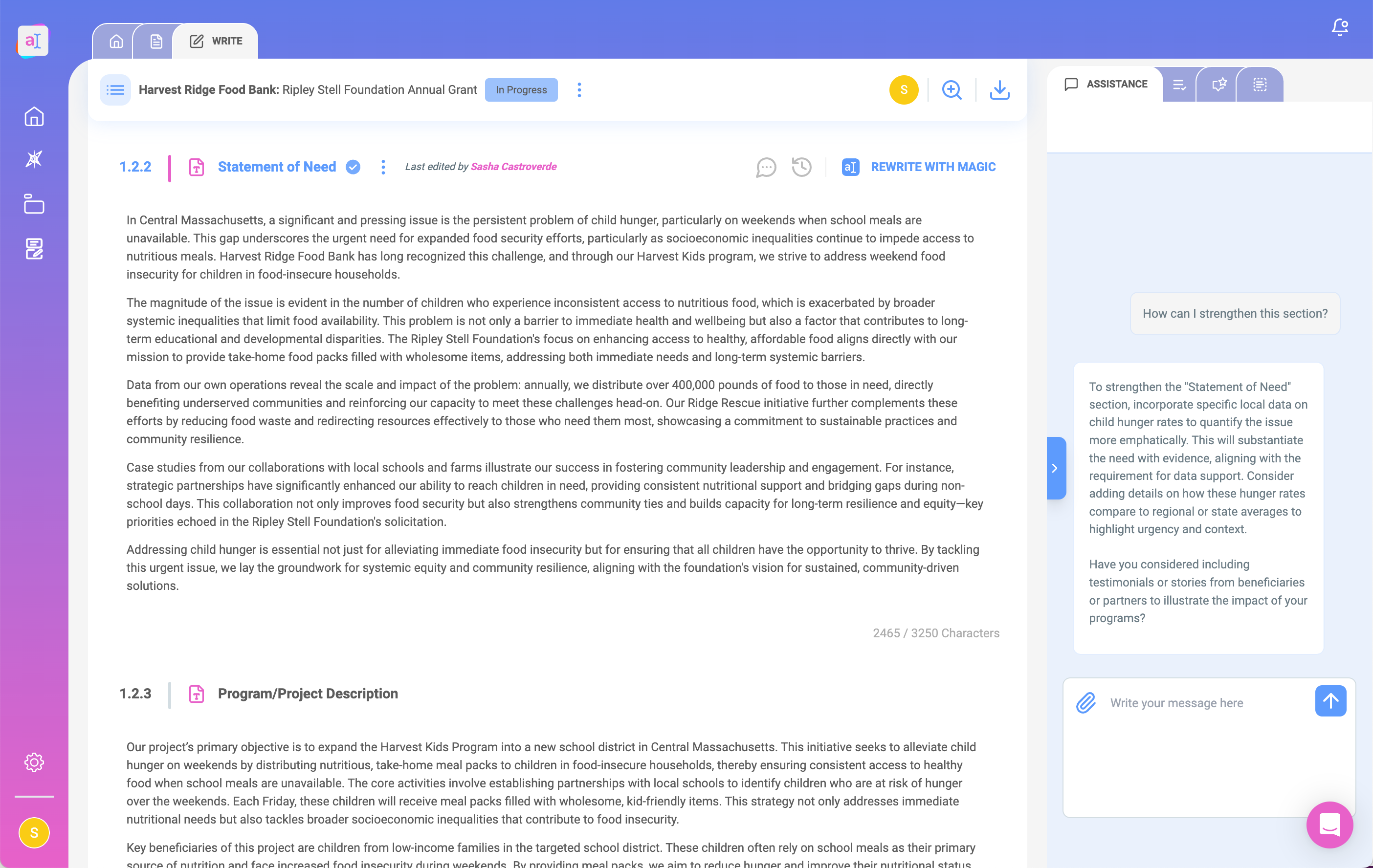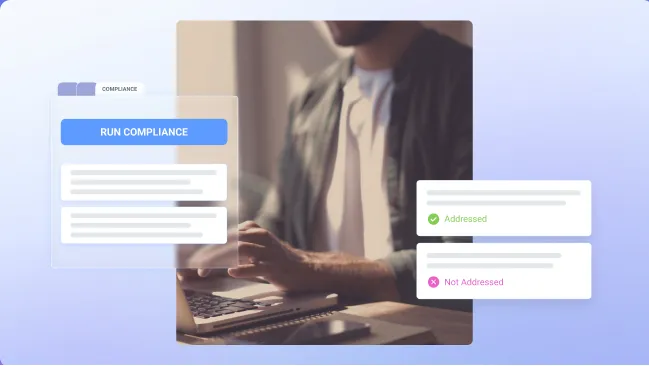Artificial intelligence has opened a new era of productivity for nonprofits. Across the sector, organizations are using AI to simplify time-intensive work—including everything from donor engagement to grant writing.
A 2024 study found that 90% of nonprofits have already implemented AI for at least one operational or marketing purpose. The benefits are clear: when used strategically, AI enables nonprofits to identify opportunities faster, write stronger proposals, and dedicate more time to serving their communities.
But with hundreds of tools now available, how do you know which AI platforms truly help you win more funding?
This guide breaks down the top AI grant writing tools for nonprofits, from comprehensive software platforms to specialized apps that complement your workflow.
✨ If you’re just getting started, check out our article:
Can you use AI for grant writing? What you need to know
What exactly are AI grant writing tools?
AI grant writing tools use machine learning and natural language processing to automate or accelerate parts of the grant application process. But not all tools are created equally.
There are two main categories you’ll encounter:
1. Purpose-built AI grant writing platforms for nonprofits
These tools—such as Grant Assistant—are designed specifically for the grant cycle. They understand funder language, proposal formats, and the nuances of nonprofit communication.
They can help you:
- Research and prioritize grant opportunities.
- Analyze RFPs to extract key requirements.
- Draft or refine proposals in your organization’s voice.
- Ensure compliance with funder guidelines.
2. General-purpose generative AI tools
Systems like ChatGPT, Claude, and Gemini can support certain grant tasks but are not specialized for the nonprofit sector. They’re great for summarizing reports, brainstorming language, or analyzing data, but they require close oversight and can produce incorrect or irrelevant information if not guided carefully.
Why AI matters for grant writing—but has limits
AI can automate large portions of the grant writing process, yet it can’t replace human expertise. Crafting a winning proposal involves logic, empathy, and storytelling—qualities that no algorithm fully replicates.
Think of AI as a collaborator, not a substitute. The technology shines when handling repetitive or analytical work, freeing your team to focus on strategy, creativity, and relationship-building with funders.
Before committing to a tool, ask:
- What steps of my grant management workflow could AI safely streamline?
- Do I have the capacity to review and refine outputs?
- Does the platform align with our privacy and data standards?
The top AI grant writing platforms for nonprofits
Below are the leading AI solutions that support grant writers and nonprofit professionals. Each brings a unique mix of automation, collaboration, and data analysis capabilities.
Grant Assistant by FreeWill: Best for comprehensive AI-powered grant writing
Grant Assistant—part of the FreeWill suite—is widely recognized as the most advanced AI grant writing platform available today. Trained on over 7,000 successful grant proposals and built by a team including former USAID senior leaders, it combines precision, security, and adaptability.

Its key strengths include:
- Analyzing RFPs and identifying eligibility or compliance gaps.
- Generating tailored drafts that match funder tone and requirements.
- Reducing writing time by up to 70%, letting users complete proposals in one-third of the usual hours.
- Protecting data with strict privacy standards and closed-system architecture.
Whether applying for federal, foundation, or international development grants, Grant Assistant adapts to your mission’s needs while maintaining your authentic voice.
👉 Learn more about Grant Assistant or schedule a personalized demo here.
Grantable: Best for flexible drafting and collaboration
Grantable helps nonprofits and institutions produce well-structured proposals quickly. Users can upload materials, co-edit with the AI, and generate professional drafts that align with funder expectations.
Pros include:
- Intuitive collaboration features.
- Ability to maintain tone and clarity.
Limitations include:
- Fewer research and analysis capabilities than Grant Assistant.
- Transparency about AI training data is limited, meaning results may require closer supervision.
Instrumentl: Best hybrid platform for research + AI drafting
Instrumentl has long been a favorite for grant discovery and tracking. In 2025, the company introduced Apply, an AI module that generates proposal drafts using Instrumentl’s extensive funding database.
If you already use Instrumentl for research, integrating Apply can save hours during early drafting and review stages.
Pros include:
- Robust discovery and tracking tools.
- Discover, write, and manage awards all in one place.
Limitations include:
- Restricted to grants already listed in Instrumentl’s system.
- Less flexibility to edit text and customize proposals
Other notable AI-powered grant tools
Beyond these top-tier options, many emerging tools provide valuable support for specific grant writing tasks.
Grant Orb
Designed to create full proposals in minutes, Grant Orb can generate content from uploaded files and prompts. However, its transparency about data sources and nonprofit training is limited—so use it for first drafts, not final versions.
Grantboost
Grantboost mirrors Grant Orb’s features at a lower price point. It’s simple and accessible, but it lacks advanced nonprofit-specific customization.
General-purpose AI tools that support grant writing
These broader platforms can accelerate specific parts of your grant process if you use them with care.
ChatGPT
The incredibly popular LLM is ideal for brainstorming, summarizing RFPs, and comparing documents. Paid plans (Team and Enterprise) add data controls and file analysis.
Claude
Anthropic’s Claude 3.5 Sonnet model produces high-quality, natural language outputs. Features like Artifacts and Projects make it great for sustained proposal work.
Microsoft Copilot
Embedded within Word, Excel, and Teams, Copilot helps nonprofits summarize reports, create presentations, and generate early drafts without leaving Microsoft 365.
Tip: These tools aren’t nonprofit-specific, so never input confidential donor data, and always review outputs before submission.
Gemini
Google’s Gemini integrates easily with Sheets, Docs, and Gmail. That makes it useful for drafting and analysis within familiar Google environments.
AI tools that complement the grant process
While the following platforms aren’t specifically designed for grant writing, they can make related tasks—like data management, reporting, or collaboration—far more efficient.
Perplexity
This AI research assistant prioritizes cited sources. Its Deep Research mode is excellent for finding credible references and context for proposals.
Coefficient
Using Coefficient, you can automate data analysis and visualization, turning spreadsheets into insights and visuals you can use in proposals or reports.
Fireflies
With Fireflies, you can transcribe and summarize calls automatically, helping your grant team capture discussions, decisions, and follow-ups.
Jasper
Known for marketing content, Jasper also excels at creating case studies or one-pagers that supplement grant applications. Plus, it offers a 20% nonprofit discount.
Grammarly
This well-known platform goes beyond checking grammar. It also checks tone, clarity, and consistency, helping ensure proposals meet funder requirements and word limits.
Gamma
Transform prompts into clean slide decks and one-pagers with Gamma—great for internal presentations or funder meetings.
Otter
Use Otter to record and summarize meetings, creating searchable transcripts and action lists for cross-functional grant teams.
Canva
Magic Design within Canva instantly generates branded decks and visuals—perfect for proposal summaries or board updates.
Notion AI
For teams using Notion, this tool summarizes long notes, organizes research, and answers workspace questions to keep grant materials centralized.
How to choose the right AI grant writing software
Before adopting any platform, evaluate how it aligns with your nonprofit’s capacity, goals, and data needs.
Look for:
- Nonprofit-specific design and training data.
- Strong privacy protocols and closed systems.
- Customizable voice controls to match your brand.
- Transparent pricing and support.
- Collaboration tools for multi-user editing and approvals.
Among available options, Grant Assistant checks all these boxes—and then some. It’s purpose-built for nonprofits, combines speed with security, and helps organizations of all sizes compete for major grants.
Final takeaways: AI as your grant-writing ally
AI technology is reshaping philanthropy. For nonprofits, it represents an opportunity to scale impact, write more proposals, and free staff time for mission-critical work.
By selecting a trusted, nonprofit-focused partner like Grant Assistant, your organization can confidently integrate AI into its workflow—turning hours of manual labor into streamlined, strategic output.
As you refine your grant workflow, keep learning with these resources:
- Can you use AI for grant writing? What you need to know
- Top 10+ grant writing software picks and supplemental tools
- Grant management software: Buyer’s guide & top-rated options
- Webinar: Five practical AI uses for nonprofit fundraising





